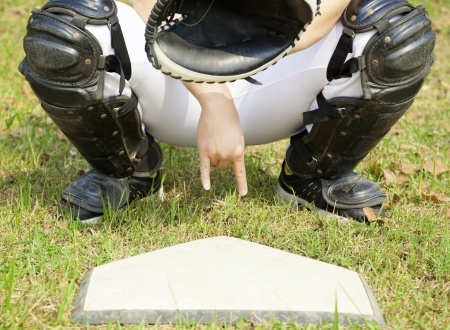Reading the Signs - Communication Between the Catcher and Pitcher
As if we needed another reason for why baseball is cool, this article will share another: The confidential catcher-pitcher relationship that is crucial to any baseball team’s success. Every catcher and pitcher uses a series of hand signals and gestures to communicate. The catcher sends signals to the pitcher, generally a sign consisting of a combination of four fingers flashed with the throwing hand. The pitcher may then give a sign (for instance, a nod) and fire off the pitch, or give an indication that they want a different pitch. The catcher also signs the direction for the pitch’s location.
Baseball’s method of using coded sign language comes from civil war days, when officers seeking to conceal their battle plans would use signs to communicate to other officers and soldiers. A system known as “wig-wag”using both torches and flags was used by Confederate soldiers who wanted to tip each other off about the movement of Union infantry. Not much longer after that, cadets at West Point would use winks and other gestures to inform each other about upcoming bunk inspections.
Unique Languages
Every pitcher has their own unique set of signals, so a catcher’s got to know every dialect of every pitcher on the team to prevent critical mix-ups. There are some major league teams that have upwards of twenty pitchers! The most common signs for basic pitches are as follows:
One Finger = Fast Ball
Two Fingers = Curve Ball
Three Fingers = Slider
Four Fingers and/or Wiggle Fingers = Change Up
All of this, of course is subject to change, and as you know, it changes with every pitcher. Type of pitch and pitch location is the bread and butter of what is communicated between pitcher and catcher. The above list is the most simple, rudimentary example of calling pitches, here are some other examples:
Catcher shows two fingers (Curve Ball) and then one finger (odd numbers = Away).
Catcher shows one finger (Fast Ball) followed by two fingers (even numbers = Inside).
Of course, these are still simple examples. The Catcher may use only fingers for sending messages, or only body signals (touching mask, thigh, chest) or an integration of both to send very specific messages. Some catchers swear by using fingers only, because a twist of the forearm or wrist could let an experienced coach know what pitch you’re calling. Sign methodology definitely gets more complex once there are players on base.
Not the Only Silent Conversation on the Field
Of course, the opposite team and staff are trying to crack each other’s codes, which is why there are hundreds of signals that are guarded like national secrets from team to team. The catcher is giving signals from a squatting position, signing hand between the legs, trying to obscure the message from the opposite team. This may sound easy, but here is what is involved if you find yourself behind home plate as catcher, trying to hide your signals:
– Your signs need to be way back in between your legs, as close to your body as possible, and not too low, otherwise the signs are just visible beneath your legs, and you’ll give away the information.
– Don’t move quickly, move deliberately and concisely, give the pitcher time to see the signs, but not so much time that your hitter can peak at what you’re doing.
Speaking of the hitter, wait until the hitter is set in the box and ready to hit before you throw your sign.
-You need to perfect “the art of the squat”so that your legs are apart, but close. Ideally you want to point both your knees toward the middle infielders to prevent sign stealing.
– Block your signs with your glove hand to prevent the third base coach from seeing what you’re signing, and only give your signal when the pitcher is on the pitching rubber.
– If it’s getting dark or other vision problems are a possibility, wear athletic tape or paint your fingernails white (some catchers just use white out) or you can switch to body signals.
– When in doubt, and you have a player on base, approach your pitcher on the mound to discuss the next series of signs you’ll switch to for the next round of hitters.
Trying to hide signals, keeping up good chemistry with the pitcher, watching signs from both pitcher and coach, keeping an eye on base runners and bases, as well as remembering the habits of every hitter in the line-up is why many consider the position of catcher to be the most significant player on the field.
Next time you’re watching a game, in person or on the tube, watch the pitches and see if you can understand what is being said between the pitcher and the catcher.

